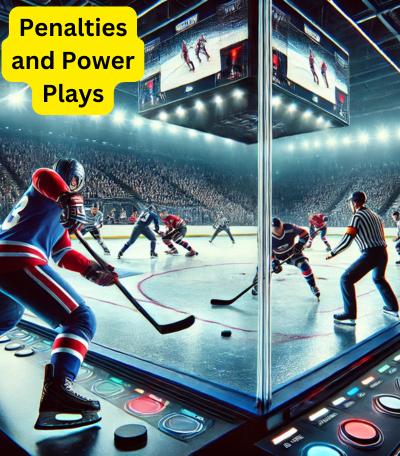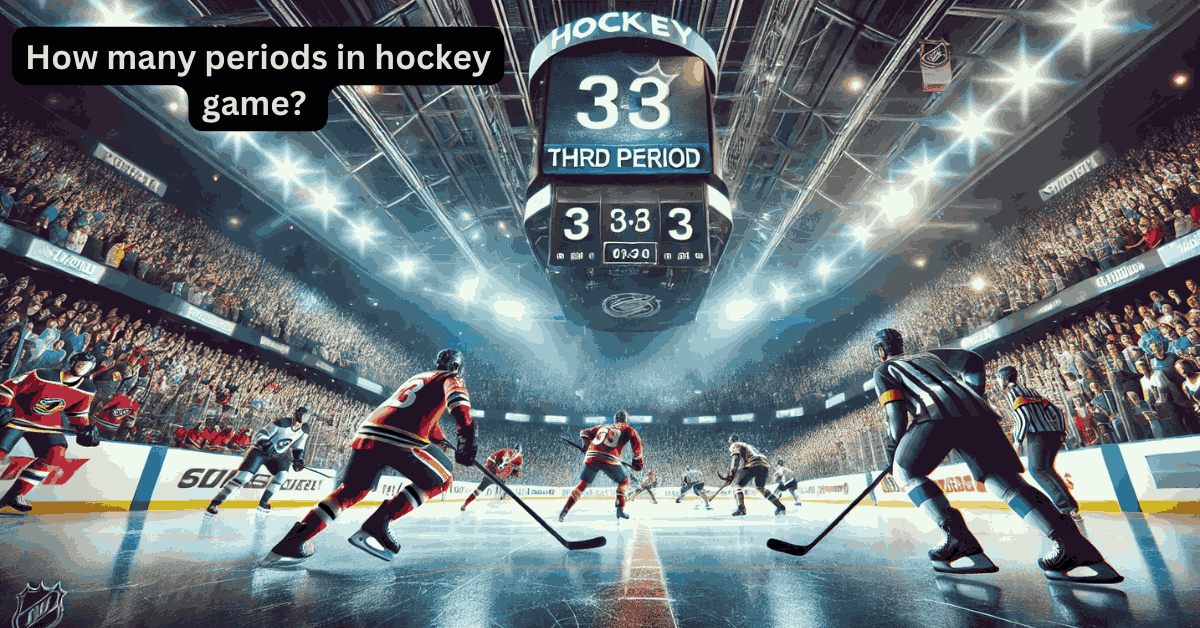Knowing and learning about hockey in giving the game of hockey is very important for a player today we will tell you How many periods in hockey game A professional hockey game consists of three 20-minute periods.This game takes more time because of stoppages and more overtime.
How many periods in hockey game? simple explain
Hockey has three periods one period is 20 minutes long and the total time is 60 minutes.Even in three periods of hockey if the score is equal 5 more minutes are added.During the playoffs ties will be settled with sudden-death overtime consisting of 20-minute periods, followed by a shootout if necessary.
How many periods in hockey AHL?
An American Hockey League (AHL) hockey game is structured with three 20-minute periods, providing a dynamic and fast-paced experience.
Key Details:
- Game Clock: The clock stops during any play stoppages, ensuring every second of action is accounted for, and no time is lost.
- Intermissions: Between periods, there are 15–20 minute breaks. These intermissions serve multiple purposes—players rest and recharge, coaches analyze gameplay to adjust strategies, and the ice is resurfaced to maintain optimal playing conditions.
- Overtime Rules: If the game remains tied after regulation time, it advances to overtime. In this sudden-death format, the first team to score a goal secures the victory, creating an intense and thrilling conclusion to the match.
Understand hockey game
Hockey game structure
Ice hockey has three rest periods which makes it different from many other sports. Each period has a 20-minute break in which the players rest and give each other some advice on how to play the game well.
If the game is tied more time is added to it which gives the results of the game for one team. The format of overtime matches match play, usually with a death period where the team with the highest score wins.
Hockey rule
- Faceoffs:When the game is stopped, the referee stands between the two opposing players when he signals the game to start.
- Powerplay: This is when the other team has more players on the ice.
- Penalties:When a player violates the rules or plays improperly So they put him out temporarily.
Hockey ice game Vs other sport
Every sport is different in its own way and ice hockey is unique in its own way. Come see what’s unique:
- Playing Surface: Ice hockey is played on a meticulously maintained frozen rink, embodying the essence of a winter sport. It demands exceptional athleticism, with players mastering the art of high-speed skating, intricate puck handling, and quick decision-making on an icy battlefield.
- Hockey stuff: Hockey players wear protective equipment such as skates, helmets, and padding for their safety.
- Penalties: Ice hockey maintains strict discipline through a system of penalties, which are issued for rule violations. Minor infractions, such as tripping or hooking, result in brief time-outs for players, while major offenses, like fighting, carry harsher penalties to uphold the integrity of the game and ensure player safety.
- Game Length: Ice hockey stands out with its distinctive structure of three 20-minute periods, setting it apart from sports like basketball and soccer, which are divided into halves or quarters. This format adds to the game’s intensity, as each period provides a fresh opportunity for teams to strategize and compete at a high level.
Duration of Periods and Intermissions
A standard hockey game is structured into three periods, each lasting 20 minutes of intense action. Between these periods, teams get a 15 to 18-minute intermission, providing a chance for rest and ice resurfacing. The game clock stops during interruptions in play, such as when the puck goes out of bounds or when a whistle blows, making the total duration of a game about 2.5 hours in real-time.
Stoppages and Timeouts
Hockey games are punctuated by various stoppages, which can be caused by:
- Icing
- Offside
- Puck going out of play
- Penalties
- Injuries
In addition to these regular stoppages, each team has one 30-second timeout per game. This short break offers an opportunity for teams to recharge, recalibrate their strategy, and make crucial decisions for the rest of the game.
Impact of Periods on Player Strategy
The division of the game into three periods plays a crucial role in shaping team strategy. As the game progresses, teams continuously adjust their tactics to maintain control and stay competitive. Key elements influencing strategy include:
- Fatigue: As the game advances, player fatigue becomes a real factor. To counter this, teams rely on quick line changes and use intermissions to recover, ensuring players stay sharp and maintain their energy levels throughout the game.
- Score Situation: The score significantly impacts strategy. If a team is ahead, they may adopt a more defensive approach, protecting their lead. Conversely, a team that’s trailing might play more aggressively, focusing on creating scoring opportunities to close the gap.
- Penalties: Penalties can drastically alter the flow of a game. Power plays give teams the chance to apply offensive pressure, while penalty killing forces teams to focus on defense. Effective adaptation to these situations is key to a team’s success.
Penalties and Power Plays

Penalties are a crucial aspect of hockey, often influencing the outcome of a game by providing one team with a significant advantage.
When a player commits an infraction, they are penalized, typically serving time in the penalty box for 2, 4, or 5 minutes, or until the opposing team scores a goal. During this time, the team with the penalty plays short-handed, with one fewer player on the ice.
This creates a power play for the opposing team, giving them a numerical advantage and a better chance to score. Power plays are critical moments in the game, as they dramatically increase the likelihood of a goal being scored.
However, if both teams have players in the penalty box, the game continues at even strength. A true power play only occurs when one team has more players serving penalties than the other, tipping the balance in favor of the team with the advantage.
By understanding these key situations, you gain a deeper appreciation for the strategic complexity of hockey and the thrilling moments that arise from these power shifts.
How many periods in field hockey? Explanation
- A standard field hockey game is divided into four quarters, with each quarter lasting 15 minutes, ensuring a structured and dynamic gameplay format.
- In 2019, the International Hockey Federation (FIH) officially adopted the 15-minute quarter system to increase the game’s pace and allow more opportunities for strategic adjustments.
- Before this change, international matches were commonly played in two 35-minute halves, offering fewer breaks for teams to regroup and strategize.
- At the high school level, game formats can vary, with some matches still using two halves instead of the quarter-based structure.
- If a game ends in a tie after the fourth quarter, it is usually declared a draw.
- However, depending on tournament rules, extra time, sudden-death overtime, or shootouts may be introduced to decide the winner, adding excitement and ensuring a conclusive result.
Other rule hockey game
- Each team is made up of 11 players, all contributing to the collective effort on the field.
- Players wield a curved stick to skillfully control and strike the ball, aiming to score by placing it into the opposing team’s goal.
- Substitutions can happen at any moment, allowing teams to adjust and refresh their lineup throughout the game.
- The field is smaller than a soccer pitch, which results in a quicker, more intense pace of play.
Were NHL Hockey Games Always Played in 3 Periods?
NHL games haven’t always been structured with three periods.
Before the 1910-11 season, NHL games consisted of two 30-minute periods. However, the shift to three periods was made for a simple, yet important, reason: the quality of the ice.
The league decided that resurfacing the ice every 20 minutes instead of 30 would provide better playing conditions. As the game progresses, the ice surface begins to wear down. Snow builds up, grooves form, and ice chips appear, all of which affect how the game is played.
The buildup of snow slows the game down because the puck can’t glide as smoothly due to increased friction. Grooves in the ice can cause players to lose their speed and momentum, impacting their performance.
More dangerously, ice chips can cause players to trip unexpectedly. Worse, a player’s skate could get stuck in a groove or chip, leading to serious injuries like sprains or torn ligaments.
By changing to three periods and resurfacing the ice more frequently, the NHL ensured the game stayed fast, safe, and exciting for both players and fans.
Conclusion
In conclusion understanding the fundamentals of hockey periods and game duration greatly enhances your appreciation of the sport. Let’s quickly recap the key takeaways:
- Hockey games are made up of three periods, each lasting 20 minutes.
- There’s a 17-minute intermission between periods, providing teams a chance to regroup and strategize. An NHL game typically lasts around 2.5 hours.
- Keep in mind the overtime and shootout rules for various leagues:
- NHL regular season: 5-minute 3-on-3 overtime followed by a shootout if needed.
- NHL playoffs: Continuous 20-minute 5-on-5 overtime periods until a winner emerges.
- International tournaments: Overtime formats can vary, such as 4-on-4 or 3-on-3.
- Lastly, penalties and power plays also play a significant role in the game’s strategy and flow.
By familiarizing yourself with these key elements, you’ll not only deepen your understanding of hockey but also enhance your overall enjoyment of the sport. for more information visit this site sportweb.info
FAQS
- How many periods are in a standard hockey game?
A typical hockey game is divided into three periods, each lasting 20 minutes. This format is used in major professional leagues, such as the NHL. - Why is hockey played in three periods instead of two halves?
The three-period structure was introduced to allow for regular ice resurfacing between periods. It helps maintain optimal ice conditions and keeps the game fast-paced by reducing friction from snow buildup and preventing grooves or ice chips from forming. - How long are the breaks between periods in hockey?
There is a 17-minute break between the first and second periods, as well as the second and third periods, to allow teams to rest, reassess their strategies, and prepare for the next period. - Are there any leagues that don’t use three periods?
While three periods is the standard for professional leagues like the NHL, some youth and amateur leagues may use two halves instead. This can vary based on local regulations and the level of play. - What happens if the game is tied after the three periods?
If the score is tied at the end of three periods, overtime is used to determine the winner. Overtime rules differ by league, with options like 3-on-3 or 5-on-5 play, often followed by a shootout if needed. - Do international hockey tournaments use the same period system?
Most international hockey tournaments follow the same three-period format, though the overtime rules might vary, depending on the competition. Some tournaments may adopt different formats for overtime, such as 4-on-4 or 3-on-3 play.
RELATED ARTICLES
Are all girls youth soccer clubs pay to play?

